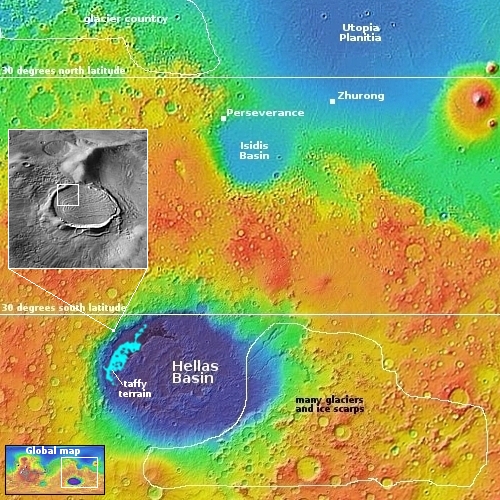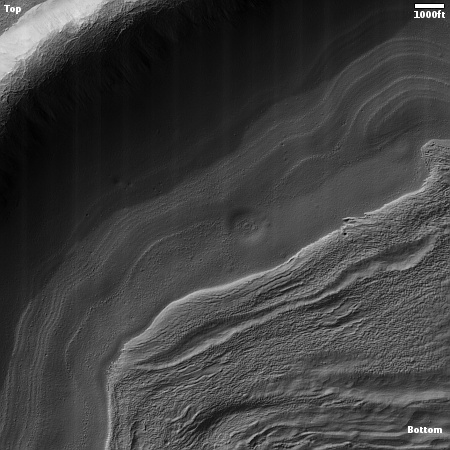A low mid-latitude crater on Mars apparently filled to overflowing with ice
Cool image time! The picture to the right, rotated, cropped, reduced, and sharpened to post here, was taken on June 18, 2023 by the high resolution camera on Mars Reconnaissance Orbiter (MRO). It shows a steep 1,000-foot-high cliff with what appears to be extensive glacial material at its base.
The many layers all suggest past climate cycles, where snow was deposited and the glacier grew, followed by a period when no snow fell and the glacier either shrank or remained unchanged. The terraced nature of the layers near the base of the cliff suggest that with each active cycle less snow was deposited and the glacier grew less.
The latitude is 33 degrees south, which puts it just outside the dry equatorial regions of Mars and inside the mid-latitude region where many such glacial features are found. Its closeness to the tropics however is significant, because by this point we should be seeing a diminishment of such features. Instead, the wider view shows us that the near surface ice in this region is extensive and in fact appears to cover everything.

The white dot on the overview map to the right marks this location, with the white rectangle in the inset showing the area covered by the picture above. The inset, created from a mosaic using the full global coverage of MRO’s context camera, also shows that this eight-mile-wide unnamed crater is practically filled with that glacial material, so much so that on its eastern margin it appears to have pushed the crater rim to the east in its effort to flow beyond.
Nor is that the only place where there is a lot of evidence of near surface ice. The mountain to the north, with a peak about 4,000 feet higher than the floor of the crater, is surrounded by an apron of glacial material, and the rough terrain to its immediate right resembles a broken ice sheet. The crater itself appears surrounded by a splash apron, and in wider views of the global context camera mosaic there are many other craters in all directions that are equally filled with icelike features.
The location, in the mountains to the northwest of Hellas Basin, might explain the extensive ice. The prevailing winds here come from the south out from the basin, and might bring with cold air that helps ice form and survive.
On Christmas Eve 1968 three Americans became the first humans to visit another world. What they did to celebrate was unexpected and profound, and will be remembered throughout all human history. Genesis: the Story of Apollo 8, Robert Zimmerman's classic history of humanity's first journey to another world, tells that story, and it is now available as both an ebook and an audiobook, both with a foreword by Valerie Anders and a new introduction by Robert Zimmerman.
The print edition can be purchased at Amazon or from any other book seller. If you want an autographed copy the price is $60 for the hardback and $45 for the paperback, plus $8 shipping for each. Go here for purchasing details. The ebook is available everywhere for $5.99 (before discount) at amazon, or direct from my ebook publisher, ebookit. If you buy it from ebookit you don't support the big tech companies and the author gets a bigger cut much sooner.
The audiobook is also available at all these vendors, and is also free with a 30-day trial membership to Audible.
"Not simply about one mission, [Genesis] is also the history of America's quest for the moon... Zimmerman has done a masterful job of tying disparate events together into a solid account of one of America's greatest human triumphs."--San Antonio Express-News
Cool image time! The picture to the right, rotated, cropped, reduced, and sharpened to post here, was taken on June 18, 2023 by the high resolution camera on Mars Reconnaissance Orbiter (MRO). It shows a steep 1,000-foot-high cliff with what appears to be extensive glacial material at its base.
The many layers all suggest past climate cycles, where snow was deposited and the glacier grew, followed by a period when no snow fell and the glacier either shrank or remained unchanged. The terraced nature of the layers near the base of the cliff suggest that with each active cycle less snow was deposited and the glacier grew less.
The latitude is 33 degrees south, which puts it just outside the dry equatorial regions of Mars and inside the mid-latitude region where many such glacial features are found. Its closeness to the tropics however is significant, because by this point we should be seeing a diminishment of such features. Instead, the wider view shows us that the near surface ice in this region is extensive and in fact appears to cover everything.

The white dot on the overview map to the right marks this location, with the white rectangle in the inset showing the area covered by the picture above. The inset, created from a mosaic using the full global coverage of MRO’s context camera, also shows that this eight-mile-wide unnamed crater is practically filled with that glacial material, so much so that on its eastern margin it appears to have pushed the crater rim to the east in its effort to flow beyond.
Nor is that the only place where there is a lot of evidence of near surface ice. The mountain to the north, with a peak about 4,000 feet higher than the floor of the crater, is surrounded by an apron of glacial material, and the rough terrain to its immediate right resembles a broken ice sheet. The crater itself appears surrounded by a splash apron, and in wider views of the global context camera mosaic there are many other craters in all directions that are equally filled with icelike features.
The location, in the mountains to the northwest of Hellas Basin, might explain the extensive ice. The prevailing winds here come from the south out from the basin, and might bring with cold air that helps ice form and survive.
On Christmas Eve 1968 three Americans became the first humans to visit another world. What they did to celebrate was unexpected and profound, and will be remembered throughout all human history. Genesis: the Story of Apollo 8, Robert Zimmerman's classic history of humanity's first journey to another world, tells that story, and it is now available as both an ebook and an audiobook, both with a foreword by Valerie Anders and a new introduction by Robert Zimmerman.
The print edition can be purchased at Amazon or from any other book seller. If you want an autographed copy the price is $60 for the hardback and $45 for the paperback, plus $8 shipping for each. Go here for purchasing details. The ebook is available everywhere for $5.99 (before discount) at amazon, or direct from my ebook publisher, ebookit. If you buy it from ebookit you don't support the big tech companies and the author gets a bigger cut much sooner.
The audiobook is also available at all these vendors, and is also free with a 30-day trial membership to Audible.
"Not simply about one mission, [Genesis] is also the history of America's quest for the moon... Zimmerman has done a masterful job of tying disparate events together into a solid account of one of America's greatest human triumphs."--San Antonio Express-News


